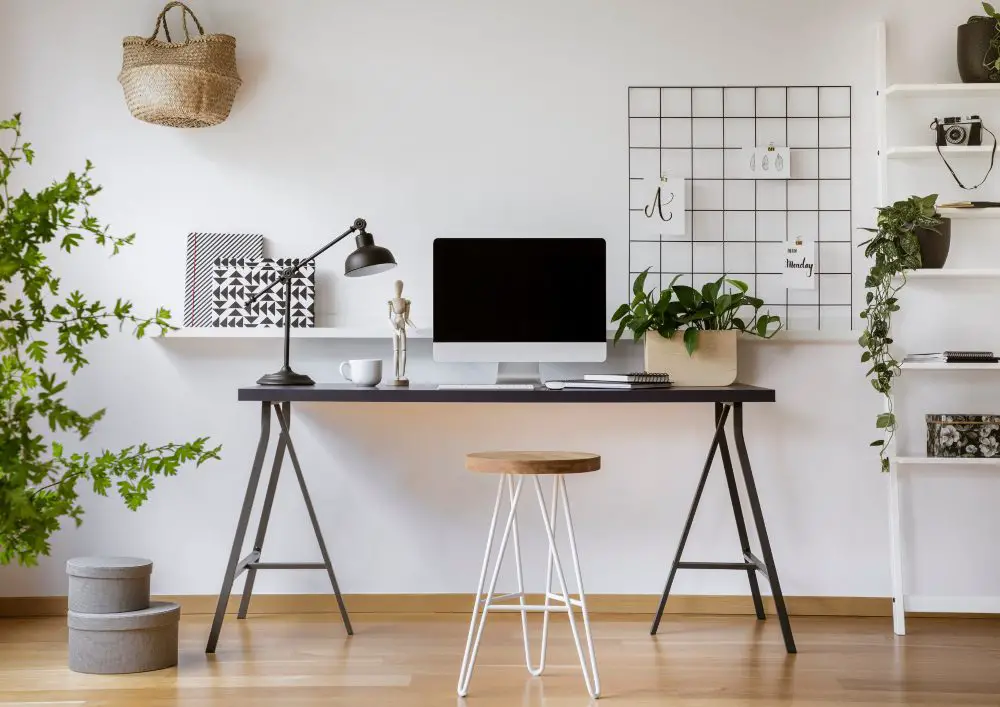Working at home is amazing. Flexibility, no commute, and the comforts of home. However, a big challenge is making a home office where you can get work done. The wrong office space makes you think of your bed and couch, which are just several steps away.
With this guide, you can design a productive home office that brings out your productivity side.
Contents
Find a Productive Home Office Space
Setting up your home office is more than snagging the comfiest chair and a desk. It’s about creating a space to knock out your to-do list while feeling good. In this section, we’ll tackle how to choose an area that lets you focus, how to get the lighting just right, and where to put all your stuff so it’s both out of the way and within reach.
Area With the Least Distraction
In today’s connected world, distractions are just a click away. The temptation to wander off into social media, household chores, or even the beckoning TV can be strong. Therefore, choosing a location in your home that minimizes these distractions is imperative for staying focused.
You want the home office space to be away from places the kids or your family occupy, like the living room. Consider a divider if you need to work in high-traffic rooms in your house. Acoustic solutions, like foam panels or rugs, can also help dampen noise from other parts of your home or outside.
Another element to consider is psychological distractions. A view of a busy street or a playground may distract your attention, making concentration difficult. Opt for a spot that offers a calming view or no view at all if that helps you focus better.
Remember, your home office is a sanctuary for work. Treating it as such will enhance your productivity and help you maintain a clear boundary between your professional and personal life.
Good Source of Natural Light & Ventilation
Good lighting and air quality can dramatically impact your home office. Natural light has proven benefits for mood and can help regulate your internal body clock. Position your desk near a window, but ensure you can control glare with adjustable blinds or curtains.
On days when sunlight is scarce, have a backup of quality artificial lighting like LED lamps that mimic daylight.
Ventilation is equally critical. Stale air can make you feel tired and lower your concentration levels while at your home office. If your workspace has no windows, consider using an air purifier or a fan to circulate air. Even opening a door to let air flow can make a difference. Plants can also improve air quality, adding a touch of nature to your workspace.
Sufficient Space For Your Equipment and Storage
A cramped home office space can hinder your workflow and make your day feel even longer. Ensure you have a spacious desk for your computer, papers, and other essential daily tools. Ergonomics is not just a buzzword; it can have real implications for your health. Ensure your monitor is at eye level and you can comfortably reach all desk areas.
Storage solutions like filing cabinets, shelves, and desk organizers can declutter your home office. A tidy desk can help you focus and find what you need faster. Consider going vertical by adding shelves above your desk if floor space is limited. These shelves allow you to make the most of your available space, giving you room to think, create, and work efficiently.
Reducing Work Strain
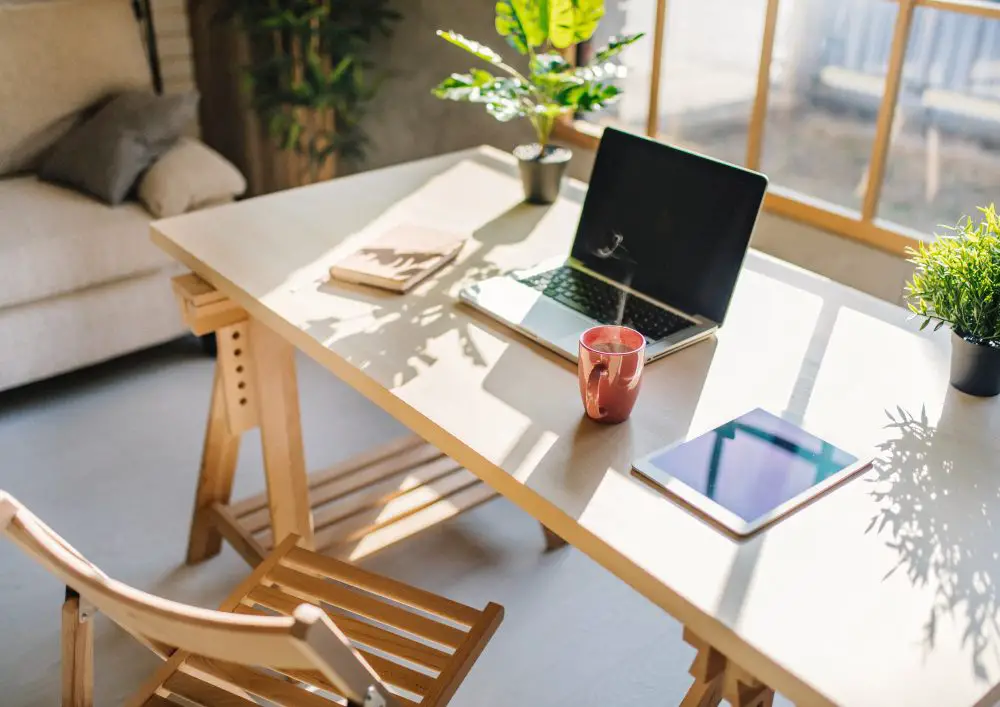
When designing your home office, the stakes are higher than aesthetics or productivity; we’re discussing your health. The following section delves into design solutions to reduce common physical ailments associated with desk jobs, such as eye strain, wrist and back pains, and overall stress.
Setting Proper Lighting
Lighting is one of an effective workspace’s most underappreciated yet crucial elements. Poor lighting doesn’t just result in an uninspiring work environment and can lead to eye strain, headaches, and reduced focus. Eye strain is essential to get your home office lighting right for productivity and well-being.
Types of Fixtures
- Overhead Lighting: Ceiling-mounted fixtures that offer general room illumination.
- Task Lighting: Desk or adjustable floor lamps for focused, directed light.
- Accent Lighting: Optional, but can add depth and highlight specific areas.
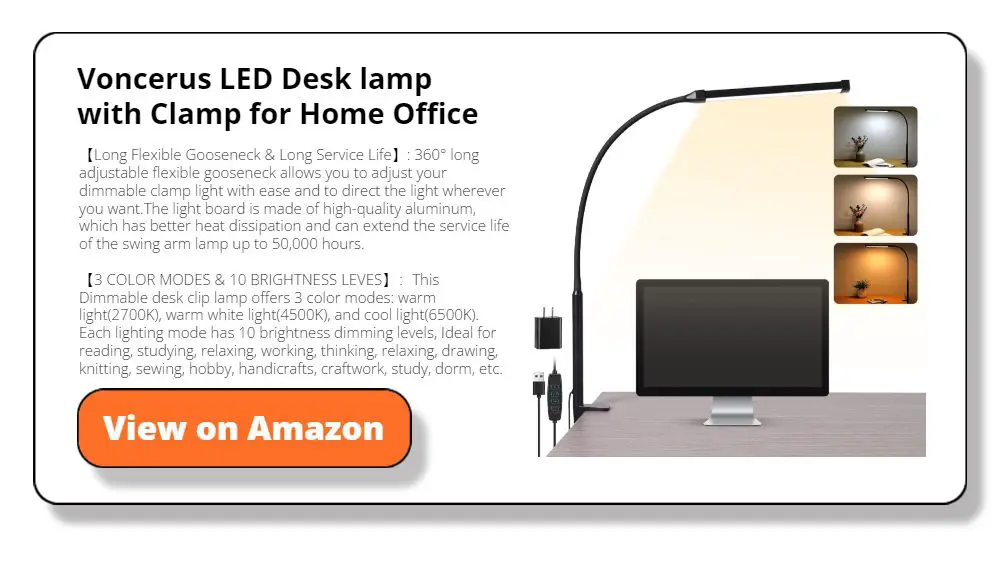
Types of Bulbs
- Halogen Bulbs: Bright, white light similar to natural daylight.
- LED Bulbs: Clear, well-distributed light with adjustable colour temperatures.
- Incandescent Bulbs: Softer light but less energy-efficient and may cause eye strain if used as the primary light source.
Avoid fluorescent bulbs, which can cause glare and contribute to eye strain in your home office. Similarly, steer clear of bulbs with lower colour temperatures that emit ‘yellow’ light, as they can be hard on your eyes during long work periods.
Think Ergonomic
Regarding home office setups, ergonomics is not a mere buzzword—it’s a necessity. Ignoring it can lead to more than just discomfort; it can cause serious health issues over time. Let’s explore some of the key furniture and gadgets that make an ergonomic difference. Your body will appreciate the attention to detail.
Furniture
- Ergonomic Chairs: Investing in a chair with adjustable features and solid lumbar support isn’t a luxury—it’s essential for long-term spinal health. Find chairs like the SIHOO Ergonomic Office Chair with strong lumbar support.
- Adjustable Desks: The versatility of an adjustable desk shouldn’t be underestimated for your home office. The ability to switch between sitting and standing can have a remarkable impact on reducing back strain.
- Footrests: When your feet don’t quite reach the floor, a footrest fills the gap and helps maintain a balanced posture.
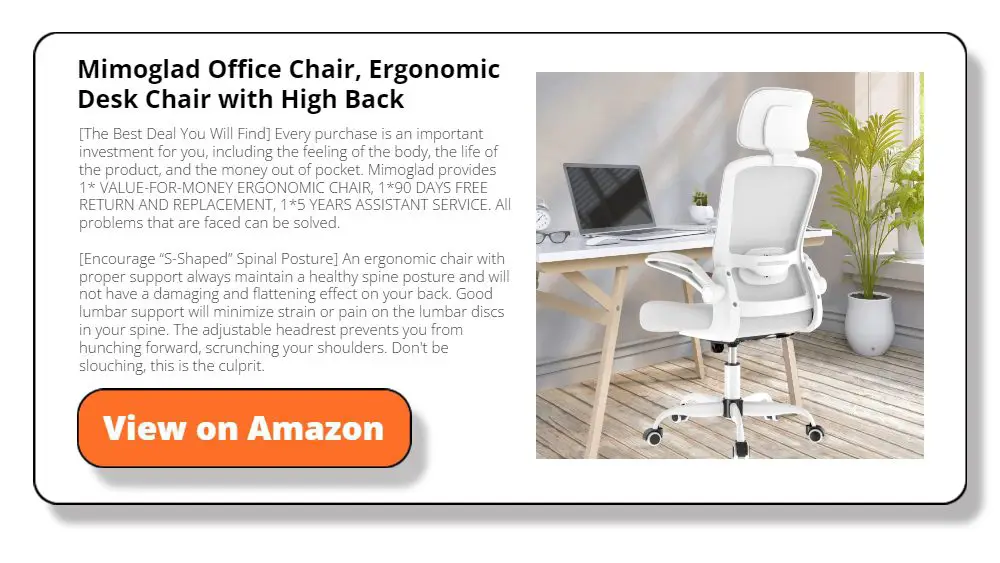
Electronics
- Monitor Stands: Elevating your monitor to eye level is crucial for minimizing neck strain while at your home office. Various stands and mounts can help you achieve this alignment.
- Ergonomic Keyboards and Mice: These specially designed devices can significantly reduce wrist strain. They support the natural curve of your hand and encourage a more neutral wrist position.
- Document Holders: Position a document holder next to your monitor if your work constantly references printed materials in your home office. A holder reduces the need to look down, thus decreasing neck strain.
Other Objects
- Wrist Rests: A simple yet effective addition. Wrist rests offer a cushioned support that mitigates the risk of carpal tunnel syndrome.
- Anti-Fatigue Mats: If you opt for a standing desk, don’t underestimate the benefits of an anti-fatigue mat. It relieves pressure on your legs and back.
Incorporating ergonomic elements need not be an overwhelming or expensive endeavour. Starting with just one or two key pieces can yield noticeable benefits. Over time, as you add more elements to your ergonomic setup, you’ll experience reduced physical strain and a more comfortable workday.
Remove Obstructions
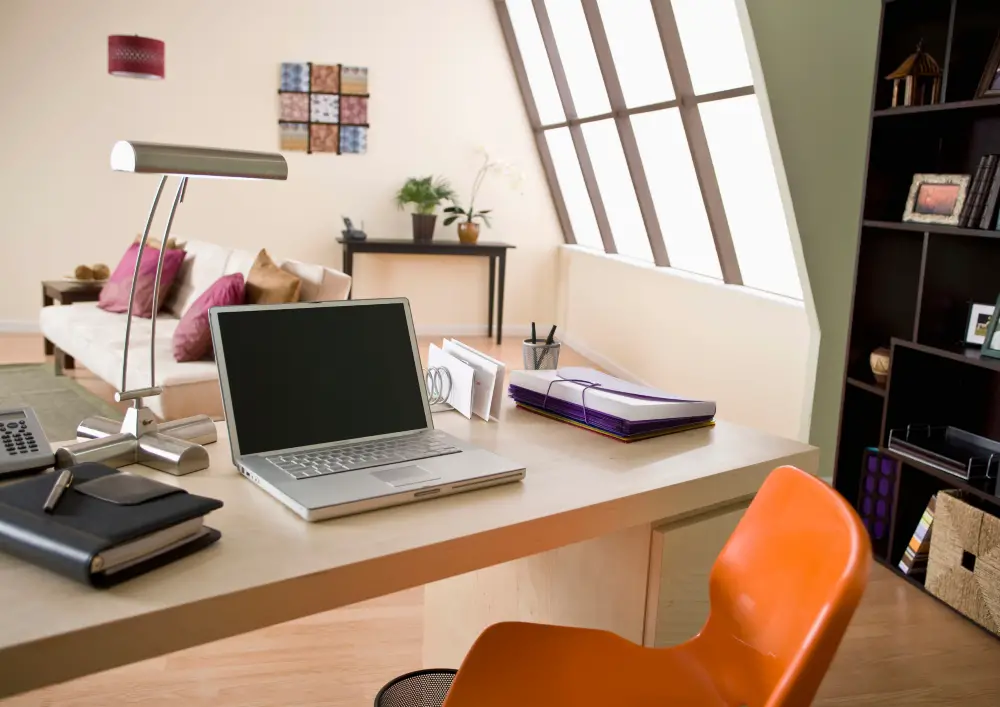
Clearing your workspace is about removing any object that does not belong in an office. Toys, bags of flour, yoga mats, and other clutter will make your mind wander to other parts of your house. Move any non-work-related objects to a different room if possible.
If you share a space with someone else, set a line where your work area begins and ends. Set a rule that no other object should be placed in this area. Doing so will help you maintain both your and your housemate’s productivity if they are also working from home. This boundary can be a divider or a simple line that indicates where your workspace starts and ends.
Efficient Workflow
Think like an office manager when planning the placement of your office equipment. Would having the printer in a corner help your employees if they need to print thousands of copies each day? Can they work better if their cameras or phones are just within arm’s reach? Finding the answers to questions like this can help you work out a good workflow for your home office.
If you frequently switch between tasks, consider using productivity techniques like the Pomodoro Technique to structure your work sessions. By focusing on creating an efficient workflow, you’ll reduce physical strain and get more done in less time.
Good Office Storage Solutions
Storage is always at the forefront of any office space. Cabinets, shelves, and hard drives keep any unnecessary clutter around your space. Having the right storage for your office can do wonders for your productivity. Here are several solutions to consider:
Furniture for Storage
- Filing Cabinets: These rectangular cabinets keep and sort all kinds of paper documents. Choose modular ones you can stack onto each other to give you more options to expand your filing cabinets if needed.
- Bookshelves: Despite its name, you can store far more objects on these shelves apart from books. Choose lightweight bookshelves that are easy to move and fit in narrow spaces.
- Desk Organizers: These organizers come in different shapes and sizes to store small objects on your desk, like pens, paper clips, and loose change. A good organizer fits with the decoration of your work area.
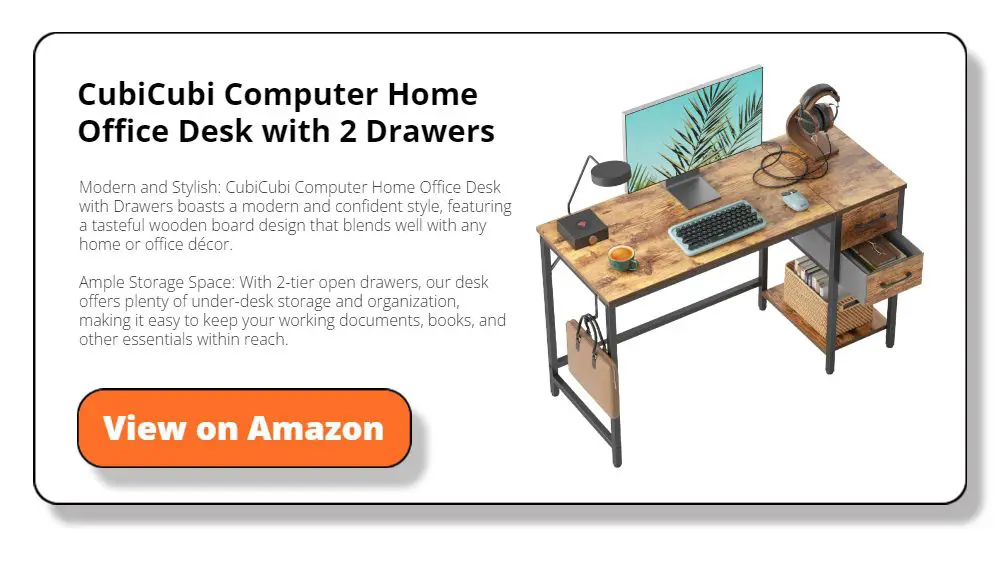
Digital Storage
- External Hard Drives: External hard drives are a must for video editors or freelancers working on terabytes worth of files. Always buy branded HDDs that are guaranteed to last a long period.
- Cloud Storage: You can sign up for a service that lets you upload and store files to an online site. This service lets you grab and store videos, documents, or images on any device.
Space-Saving Solutions
- Wall-Mounted Shelves: These can hold books, plants, or decorative items without occupying floor space. Install ones with a minimalist style to fit your office aesthetic.
- Storage Bins: Convenient for stowing away less frequently used items. A great storage bin is one you can tuck in almost any corner.
Remember, good storage is more than just stashing your stuff out of sight. It’s about creating a system that allows you to find what you need when needed. Your choice of storage solutions will not only affect your workspace’s aesthetics but also its functionality. Over time, a well-thought-out storage plan will increase efficiency and reduce stress, contributing to a healthier and more productive work environment.
Boosting Productivity

Your home office is not just a space to get things done; it’s where you should be most productive. In this section, we’ll look at design choices that make your office visually appealing and enhance your ability to focus and complete tasks efficiently.
Minimize the Cables
A mess of cables on your desk isn’t just an eyesore; it’s a productivity killer. Loose wires can make it difficult to clean your workspace, and searching for the right cord in a tangled mess can waste valuable time. Thankfully, several ways exist to reduce cable clutter and streamline your workspace.
- Go Wireless: One of the most straightforward ways to eliminate cables is by choosing wireless options. Wireless keyboards, mice, and even wireless charging pads can substantially reduce the necessary wires.
- Use a Laptop: Consider using a laptop instead of a desktop computer if possible. A laptop only requires a power cord, reducing the number of cables that need to be managed.
- Cable Management Accessories: Products like cable clips, sleeves, or under-desk trays can hide and organize the cables you can’t eliminate.
- Desks with Built-in Solutions: Some modern desks have built-in cable management features. These might include holes for threading cables through or compartments for power strips, keeping your workspace clean and tidy.
- Unified Charging Stations: These are all-in-one solutions that can charge multiple devices at once, reducing the number of individual cables needed.
Reducing cable clutter makes your workspace more visually appealing and makes it easier to focus on the task. A clean, organized desk can help boost productivity and make your workday more enjoyable.
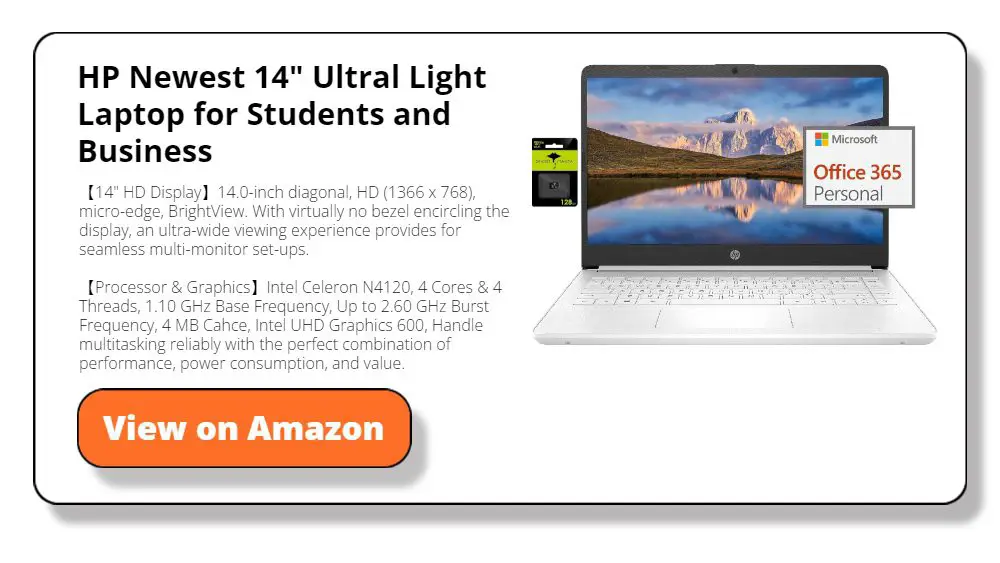
Consider Acoustics
Sound often takes a back seat when designing a home office, but it shouldn’t. The level and type of noise in your workspace can deeply impact your concentration and stress levels. Here’s how to optimize the acoustics in your home office for peak performance.
- Soundproofing: A good first step to keep outside noise at bay is soundproofing. Blocking the sounds could range from straightforward fixes like weather stripping around doors and windows to installing acoustic wall panels.
- Sound Absorption: Items like plush rugs, heavy curtains, and upholstered furniture can absorb sound within your space. These are not just aesthetic choices but functional elements that contribute to a quieter workspace.
- White Noise Machines: Sometimes, consistent noise can help you focus better than complete silence. White noise machines or apps provide a constant backdrop that masks potentially distracting noises.
- Headphones: Noise-canceling headphones can be a saviour in a noisy environment. But remember, keep the volume reasonable to protect your ears.
- Placement of Equipment: Be strategic about where you place noisy office gadgets. Printers, phones, and other machinery should be tucked away in less central areas. Consider soundproof cabinets to dampen noise further.
- Room Layout: The arrangement of furniture can also influence how sound travels. For instance, placing bookshelves against walls exposed to external noise can help dampen the sound.
Taking the time to address the acoustics in your home office can have surprising benefits. A quieter, more tranquil workspace will aid concentration, reduce stress, and, ultimately, make your workday more productive and enjoyable.
Smart Home Office Decorations
Decor in a home office is about more than just looks. It’s about creating an atmosphere that removes the mindset you are home. Great decorations will turn on your productivity side.
Let’s explore some decorations that do double duty—they look good and serve a purpose or even spark some much-needed inspiration.
- Art Pieces: Choosing the right art can make your workspace feel unique and keep you inspired. Go for pieces that resonate with you but won’t divert your focus.
- Plants: A bit of green can work wonders for your mood and air quality. Easy-care options like succulents or snake plants are ideal.
- Functional Decor: Think beyond just eye-pleasing items. Wall clocks, cork boards, or magnetic boards can be attractive and useful.
- Personal Touch: A couple of family photos or cherished mementos can make your office feel like a part of your home without causing clutter.
- Colour Psychology: Believe it or not, colour matters. Blue hues can help keep you focused, while greens tend to be calming.
- Theme Consistency: Match the colours of your furniture, paint/wallpaper, flooring, and decoration. You want the look of your office space to be different from your living space.
Decorating your home office makes you feel like the CEO of a company. You want a look that represents your brand or your work. Entering your workspace can make you feel like the company’s MVP or the hottest personality on YouTube with the right decoration.
Conclusion
The perfect home office is not about having a mahogany desk or a branded gaming chair with an influencer’s name. It is a space where you can do the best work in the comfort of your home.
Following our guide helps you create a productive office space. It also lets you decorate one that energizes you on Monday mornings.

